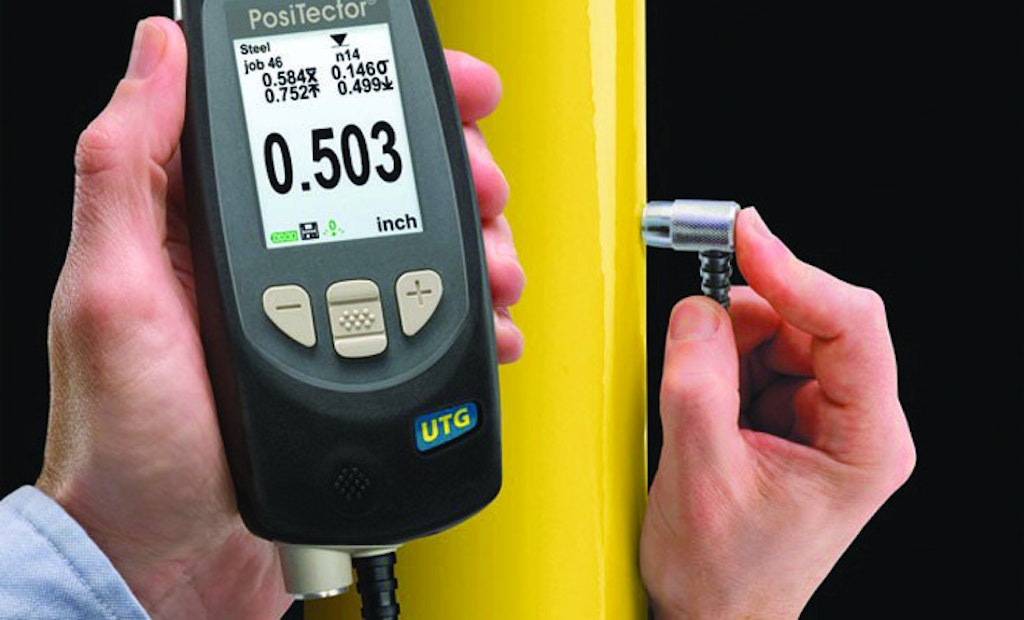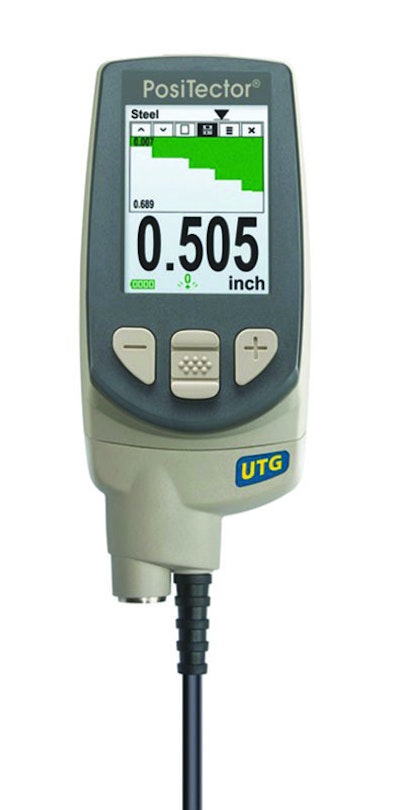
Interested in Inspection?
Get Inspection articles, news and videos right in your inbox! Sign up now.
Inspection + Get AlertsVisual inspection and routine maintenance are the two keys to ensuring the longevity and safe operation of liquid-containing tanks. When the remaining thickness of a tank wall is in doubt, ultrasonic testing can provide a definitive measurement, either at a given point, or across a broader spectrum of locations.
An electronic ultrasonic thickness gauge (UTG) can test the wall thickness of materials, including steel, aluminum and plastic, and determine the effects of corrosion or erosion on any tank structure. Initially, such devices were used inside a tank to ensure that any coating on the tank exterior wouldn’t skew the measurements. The advantage of the UTG is that it can provide an accurate measurement where access to the tank is limited to the outside — even through paint or other coatings.
The technology works by sending a pulse of high-frequency sound waves into a solid material. When the pulse detects a different material, such as air or water, the pulse is reflected back to the probe. The gauge then assesses the speed of the pulse through the material to determine its thickness.
The first hand-held thickness gauges were developed in the 1970s. The development of digital and increasingly miniaturized components has led to the creation of a broad array of sophisticated battery-powered, hand-held devices.
Truck tanks tested
Bruce Heck, owner of Alberta Tank Truck & Supply Ltd. in Drayton Valley, Alberta, has been inspecting truck tanks for the better part of a decade. While his business concentrates primarily on tank trucks serving the gas and oil industry, the testing procedures and principles are identical to those that would be used for trucks that transport sewage or water.
Heck says ultrasonic testing is generally employed in his business as part of a broader routine truck inspection, or within a full safety inspection to certify a truck to transport dangerous goods.
“If the owner suspects there’s a problem with a tank because of corrosion on the outside, or if the tank has been scraped, we occasionally provide just an ultrasonic inspection to help them to determine whether the tank should be repaired or scrapped,” he says.
Heck uses an Olympus ultrasonic tester that provides a reading of the thickness of both the paint on the tank and the tank material itself. That allows him to test tank thickness from the outside of the tank, rather than the inside. The tank does not need to be emptied to perform a successful test, since the device can differentiate between steel and whatever the tank may be carrying.
“The tester will give me separate readings on the thickness of the paint and the thickness of the tank material,” he says. “But it won’t tell me how thick they both are together.”
Gel bridges gaps
Heck uses an ultrasonic couplant gel applied to the surface of the tank to ensure the tester probe makes sufficient contact with the tank material, eliminating the slight gap of air between the probe and the surface to be tested. Various devices use different types of gel, including water, oil, glycerin and propylene glycol. However, the gel must be applied to the surface of the material, not the transducer face of the probe. The gel also reduces abrasion on the surface of the transducer, extending its service life.
When testing, the thickness readings are supplied immediately.
“We start by checking the tank in the spots where we believe it’s likely to become more thin,” he says. “Generally, we test the top third of the tank where vapor will corrode the interior surface, because liquids don’t often corrode the inside of a tank below liquid level. Vacuum trucks are also typically eroded where gritty material enters the tank. If we find a spot that’s too thin, we’ll do more tests at other spots to help determine if that tank should be repaired or discarded.”
The cost of the ultrasonic inspection is charged out at shop labor rates, usually bringing the final cost to less than $100, Heck says.
Contractors can perform ultrasonic testing themselves, using hand-held testers provided by a wide range of suppliers.
One such company is DeFelsko Corporation, a manufacturer and supplier of ultrasonic testers based in Ogdensburg, New York.
“We produce a basic model, the PosiTector UTG, that’s suitable for truck tank inspection and designed to be simple to use and ready to go out of the box,” says Scott Bate, technical sales with DeFelsko. “The default material setting for the tester is for steel and it works accurately on determining the thickness of the material to a depth of 5 inches.”
Adjusting for material
However, the probe can be set to measure the thickness of cast iron, aluminum and plastic tanks as well. The adjustment essentially represents a change in the speed at which sound travels through that particular material.
The probe comes calibrated by the manufacturer right out of the box. However, before using the probe on the material to be tested, it should first be used to measure a material sample of known thickness.
“This could be a flat bar of metal that you’ve independently measured, or you could use a calibration step block,” says Bate. “It’s a series of steps rising along a short metal bar, with the thickness measurement stamped on each step.”
A drop of ultrasonic gel must also be applied to the step block when verifying the calibration of the gauge.
“To perform an accurate test, the tank surface should first be cleaned of grease, road salt, dirt, rust or scale,” says Bate. “Otherwise, the tester will simply measure the thickness of the rust, scale or corrosion.”
If corrosion or scaling is severe, a wire brush or grinder may be necessary to remove excess material. If the surface remains irregular, application of additional gel to the rough areas can help to provide an accurate reading.
The scan should also avoid structural irregularities in the tank, such as welds. If the reading is being taken along the curved part of the tank, the gauge should be pointed directly to the center of the tank.
“The gauge always provides the most accurate reading when placed at a 90-degree angle to the material to be tested,” he says.
Scanning the surface
Bate notes that the pattern of application of the ultrasonic gel can allow the operator to perform either a spot thickness reading or a reading across a broader expanse of the tank’s surface. This helps to narrow down problem areas, particularly those where erosion or corrosion has affected individual points of the tank.
“If you spread the gel across the range of the surface you’re interested in and then set the tester to scan mode, you can pass the probe across the length of that gel,” he says. “The scan takes 20 readings per second and provides an average reading of the tank thickness across that range, in addition to the thickest and thinnest points in that part of the tank.”
The meter can also be set to emit an audible signal if the thickness of the tank material falls below a preset level at any measurement point.
Whether a contractor chooses to invest in an ultrasonic tester largely depends on the number of trucks in the fleet and frequency of inspections. The basic hand-held model from DeFelsko — the PosiTector UTGC1 — currently sells for $995.
“It’s definitely something that can be used accurately by a truck contractor without any specialized training,” says Bate.






